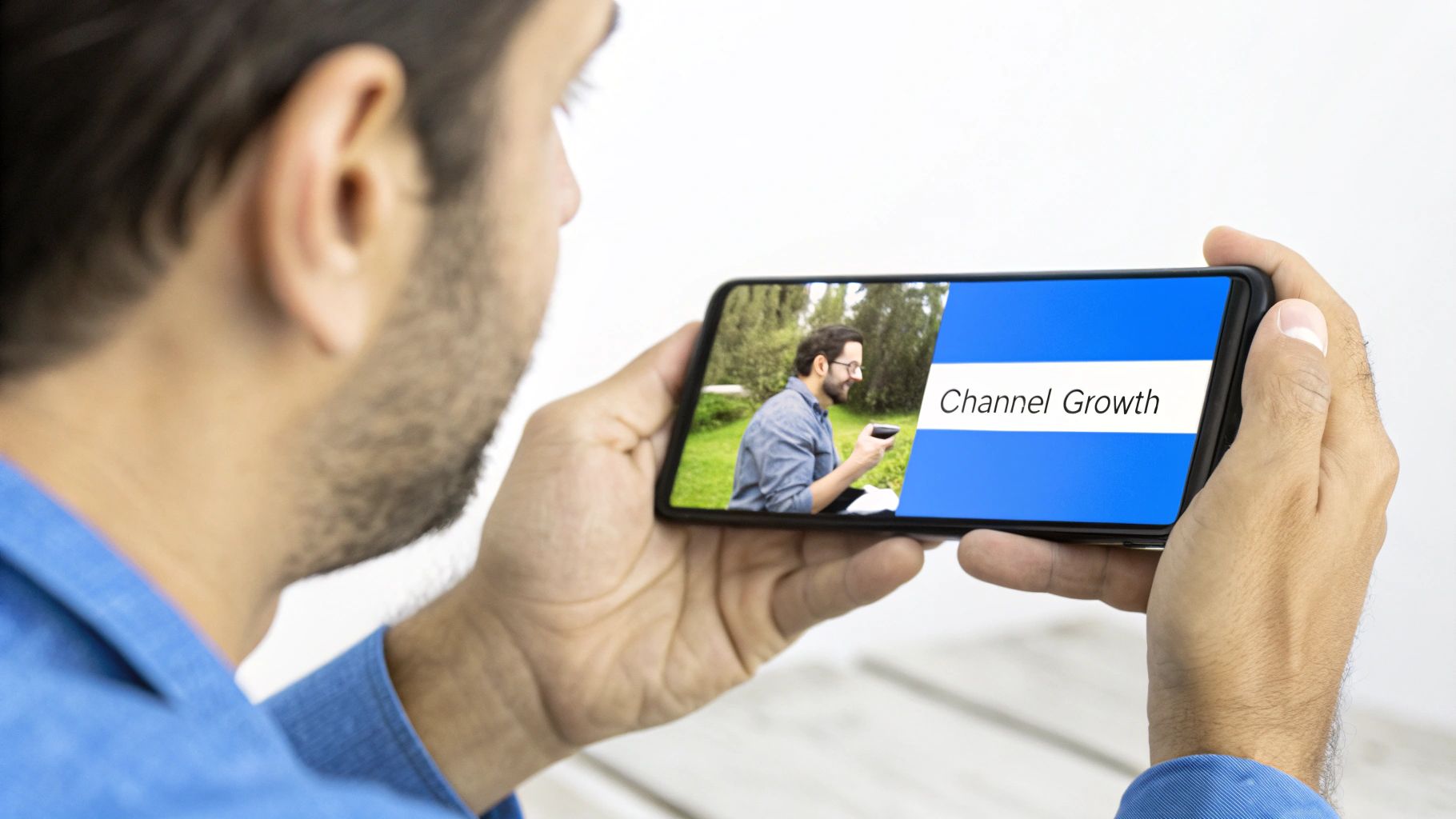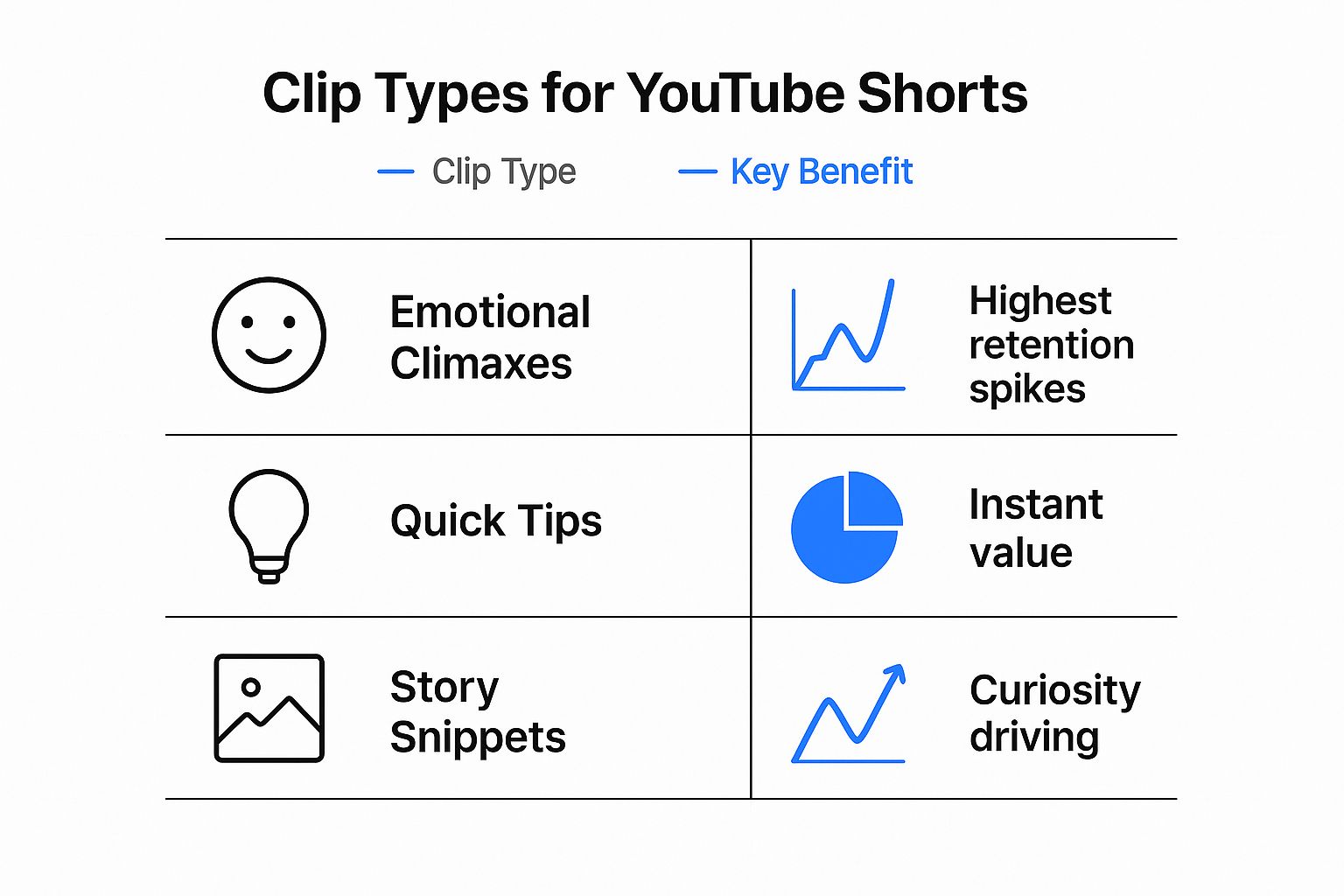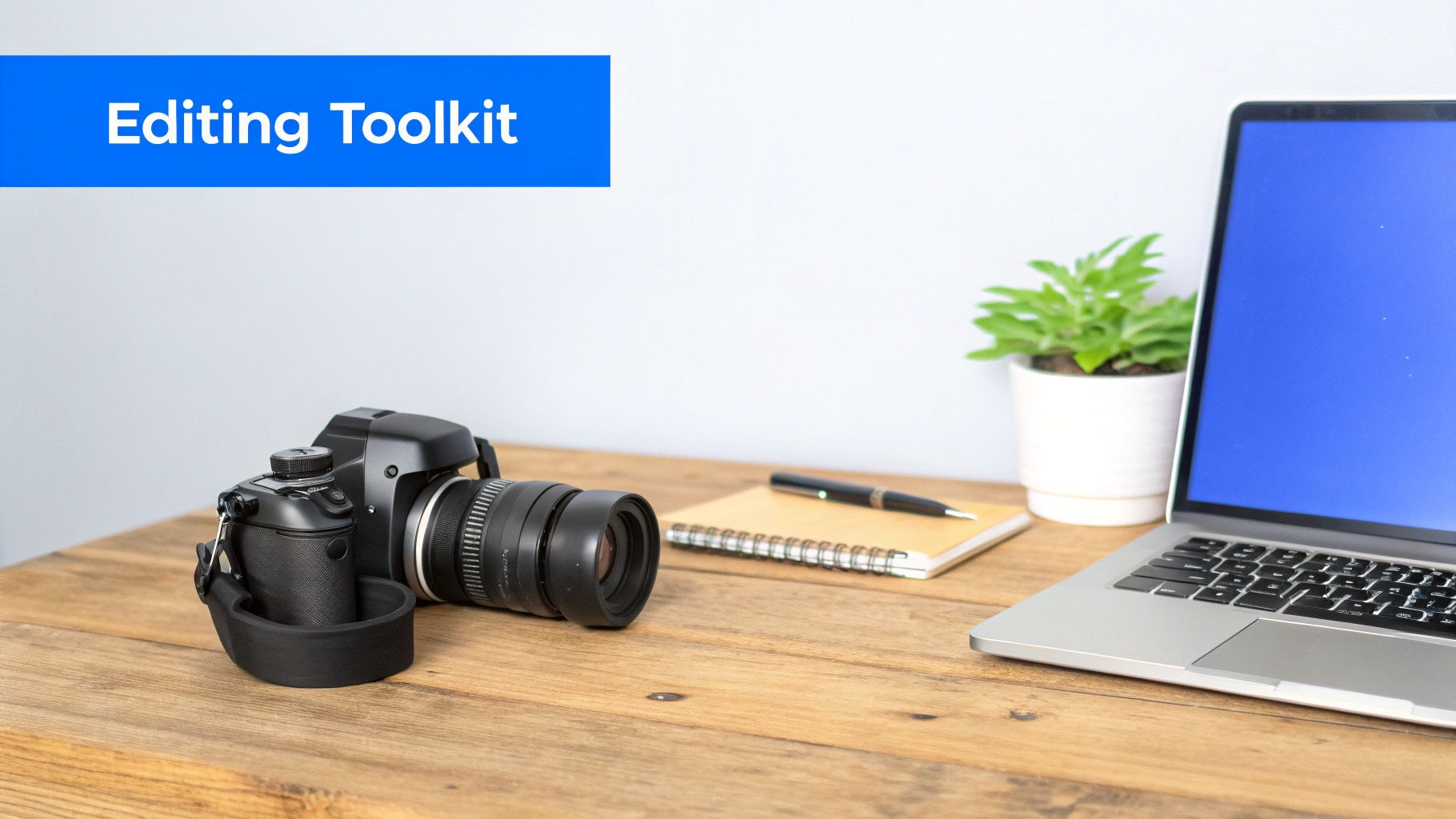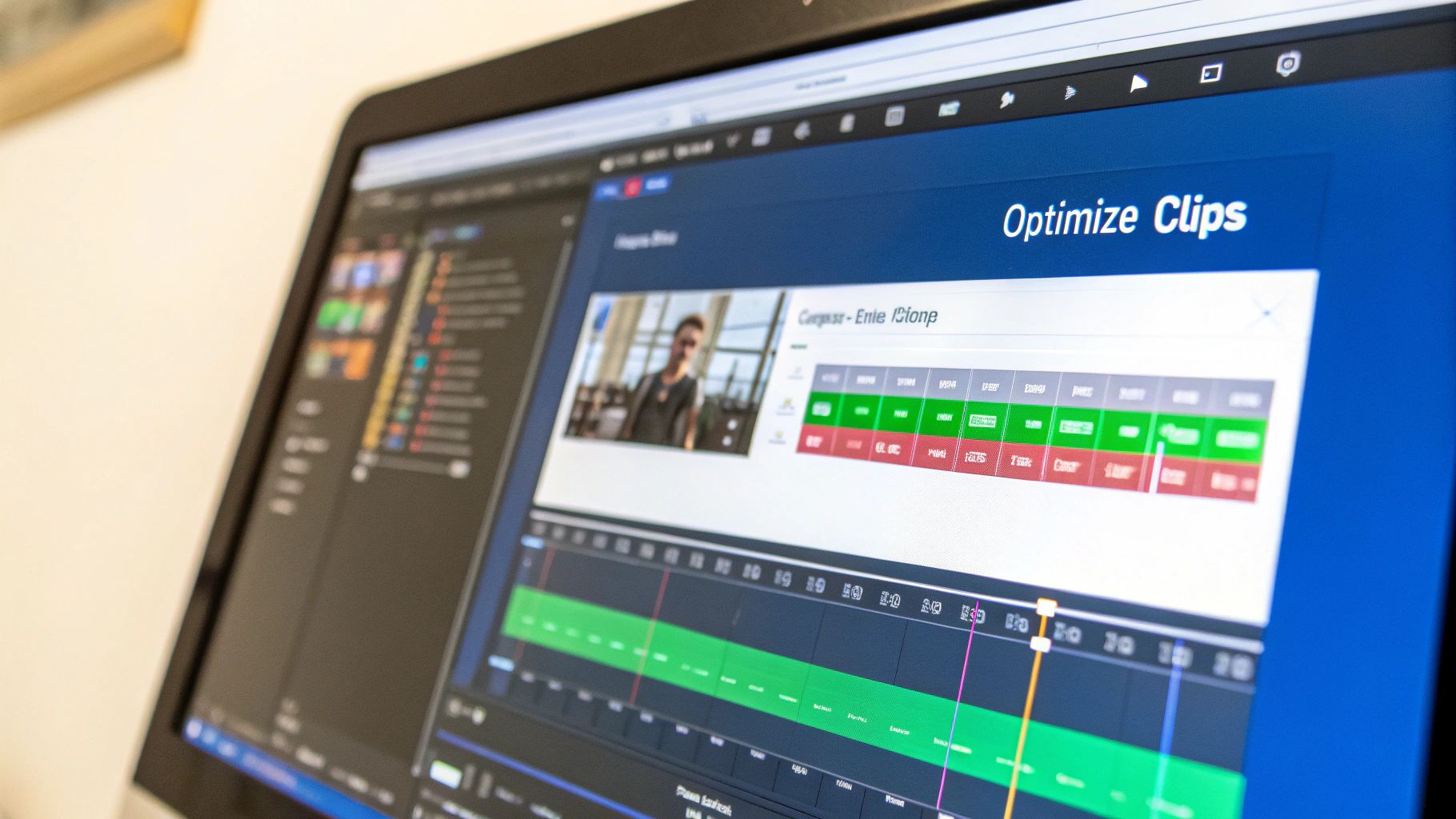Repurposing your long-form videos isn't just a clever trick anymore; it's a fundamental strategy for anyone serious about growing their channel. When you create Shorts from YouTube videos, you’re doing more than just cutting up old content. You’re tapping into a massive, mobile-first audience, playing to the strengths of the Shorts algorithm, and giving your entire content library a brand new life.
Why Turning Videos Into Shorts Is a Growth Engine

Transforming your existing videos into Shorts is one of the single most effective ways to put your channel's growth on the fast track. This isn't about creating more work. It’s about making your existing work work harder for you.
Think of each long video as a goldmine. Buried inside are countless viral moments, killer punchlines, and powerful insights just waiting to be unearthed.
By pulling out these snippets, you're essentially creating trailers for your best stuff, reaching viewers who might never sit through a 20-minute deep dive. This approach creates a powerful feedback loop where your short and long videos boost each other. The Shorts act as the hook, pulling in new subscribers, while your long-form videos provide the depth that makes them stick around.
Tapping Into a Massive Mobile Audience
The sheer size of the Shorts audience is hard to wrap your head around. Since it launched, YouTube Shorts has become a global phenomenon. By early 2025, it was pulling in a mind-boggling 70–90 billion daily views. That's a huge jump from just 30 billion back in 2021.
This explosive growth is a clear signal of a major shift in how people consume content. More than 2 billion users now engage with Shorts every single month. This is a mobile-first audience, constantly scrolling and hungry for quick, engaging content. Creating Shorts puts your channel directly in their feed, grabbing their attention in the format they already prefer.
Your best long-form content deserves a bigger audience. Shorts are the bridge that connects your deep-dive videos with millions of potential new viewers who prefer bite-sized content.
The Power of Content Repurposing
Creating Shorts from your existing library is the definition of smart content repurposing. Instead of feeling the constant pressure to come up with entirely new ideas, you can efficiently multiply your output. This isn't just about saving time; it's a strategy with some serious perks.
- Skyrocket Your Discoverability: The Shorts algorithm is built for discovery. It pushes your content to new audiences based on what they watch, not just who they subscribe to.
- Build an Audience Funnel: A great Short is the perfect advertisement for the full video. It gets viewers curious and drives them back to your main channel to see more.
- Stay Consistent (Without the Burnout): Repurposing helps you maintain a steady posting schedule, keeping your channel active and relevant in the algorithm's eyes.
Getting a handle on a few of the top content repurposing strategies is non-negotiable for any creator trying to maximize their impact without burning out.
https://shortsninja.com/blog/top-content-repurposing-strategies/
It’s all about working smarter, not just harder.
Finding Gold in Your Existing YouTube Videos
Let's be real—not every second of your long-form video is destined for viral fame as a Short. The real skill is learning to spot the "viral gold." These are the high-impact snippets that pack an emotional punch, a surprising reveal, a quick tip, or a killer punchline into just a few seconds. To get this right, you have to start thinking like a Shorts viewer.
Your best tool for this treasure hunt is already waiting for you in YouTube Studio: the audience retention graph.
Seriously, go look at the analytics for your best videos and find the peaks. Those spikes and plateaus are your audience telling you exactly what they loved. They’re pinpointing the moments they were most captivated, rewatched a section, or paused to let something sink in. These are your prime candidates for Shorts.
Identifying High-Impact Clip Types
Once you've found these high-retention hot spots, you can start to see why they work. Some clips hook viewers with a powerful emotional climax. Others offer a self-contained tip that delivers instant value. And some are juicy story snippets that leave the viewer hanging, dying to know what happens next.
This infographic breaks down the core benefits of each clip type.

As you can see, your choice of clip should line up with your goal, whether that's maxing out watch time or driving people back to the original video.
Crafting a Standalone Narrative
Here’s the most important part: the clip has to work as a self-contained piece of content. A Short should never feel like a random, confusing fragment ripped out of a longer video. It needs its own mini-narrative—a beginning, a middle, and an end—all within that 60-second window.
- Self-Contained Tips: A quick tutorial or a single piece of advice is perfect. Think of a clip showing "the one setting you need to change on your camera." It provides immediate value and feels complete.
- Compelling Cliffhangers: Cut your Short right before the big reveal. A cooking video could end just as the final dish is about to be tasted, making viewers click over to the full video for the recipe and reaction.
- Story Snippets: Pull a short, engaging anecdote from your video. The snippet needs to be interesting on its own but also hint at a larger, more detailed story in the full-length version.
Remember, a successful Short delivers a complete experience. Whether it's a laugh, a lesson, or a question, the viewer should feel satisfied yet intrigued enough to want more.
Another powerful technique is to analyze what makes other clips go viral. To really sharpen this skill, you can learn more about how to find viral trends from competitor videos and apply those same principles to your own content. Over time, you'll develop an instinct for what works in the fast-paced Shorts feed.
Choosing Your Toolkit for Creating Shorts

Okay, you’ve pinpointed the golden moments in your video. Now comes the fun part: picking the right tool to actually create Shorts from a YouTube video.
The "best" method really boils down to what you're trying to achieve. Are you chasing speed? Do you need absolute creative control? Or is simplicity the name of the game? Your answer will lead you down one of three main paths. Let's break them down.
AI-Powered Clipping Tools The Fast Lane
If you're all about speed and efficiency, AI clipping tools are your new best friend. Seriously, these things are a game-changer. They chew through your long-form video, automatically find the most shareable moments, slap on some dynamic captions, and even reframe it for a vertical 9:16 screen.
Instead of you manually scrubbing through an hour-long podcast to find that one perfect quote, an AI can spit out ten solid options in minutes. This frees you up to think about the bigger picture instead of getting bogged down in tedious edits.
Most of these tools come packed with features like:
- Automatic Reframing: The AI is smart enough to keep the speaker or main action right in the center of the frame, even when it crops the video to vertical.
- Dynamic Captions: You get those slick, animated subtitles that are crucial for capturing the 85% of users who watch videos with the sound off.
- Brand Templates: Easily apply your brand's colors, fonts, and logos to every clip for a polished, consistent look.
This route is perfect for podcasters, coaches, and anyone pumping out a ton of content. If you need to scale your Shorts game without hiring an editor, this is it. For a rundown of the top players, our guide on AI video editing tools can help you pick the right one.
https://shortsninja.com/blog/ai-video-editing-tools/
Traditional Video Editors For Full Creative Control
But sometimes, AI just doesn't get your vision. When you need total command over every cut, text overlay, and sound effect, it's time to roll up your sleeves with traditional software like Adobe Premiere Pro, Final Cut Pro, or the surprisingly powerful free option, DaVinci Resolve.
This is the path for creators who want to produce highly polished, almost cinematic Shorts. You get the keys to the kingdom—complex effects, custom graphics, precise color grading, you name it.
If your brand is built on a unique visual style or intricate storytelling, the manual control from a traditional editor is non-negotiable. It’s a bigger time commitment, but the creative ceiling is basically infinite.
Think of a filmmaker teasing a project with custom sound design and slick VFX—an AI tool isn't going to cut it. Or a comedy creator who relies on perfect comedic timing with jump cuts and zoom effects. In these cases, the extra time is an investment in quality.
YouTube’s Native Edit Into A Short Feature
Finally, don’t sleep on the tool YouTube gives you for free. The "Edit into a Short" feature is built right into the mobile app, accessible from your video's watch page. It’s designed for one thing: speed.
This is your go-to for quick, spontaneous clips. Just uploaded a new vlog and want to share a funny blooper right away? You can grab up to 60 seconds, add some basic text, and post it from your phone in less than a minute.
But that simplicity is also its biggest weakness. You have zero control over the reframing—YouTube just centers the crop automatically—and the editing options are minimal. It’s not for crafting a masterpiece, but for sheer speed, it’s unbeatable.
Comparison of Methods to Create Shorts from YouTube Videos
To make the choice a bit easier, here’s a quick breakdown of how these three methods stack up against each other. This table should help you match the right tool to your specific workflow and goals.
| Method | Best For | Speed | Customization | Cost |
|---|---|---|---|---|
| AI-Powered Tools | High-volume creators, podcasters, and educators who need to scale content production efficiently. | Very Fast | Medium | Subscription-based |
| Traditional Editors | Creators with a specific creative vision who need full control over every detail of the final product. | Slow | High | Varies (Free to high-cost subscription) |
| YouTube's Native Feature | Quick, simple clips and sharing on-the-go moments directly from a phone without any fuss. | Instant | Low | Free |
Ultimately, there's no single "correct" answer. Many successful creators use a mix of these methods. They might use an AI tool for the bulk of their daily content, a traditional editor for a big promotional push, and YouTube's native feature for spontaneous, in-the-moment updates. The key is to find the workflow that lets you create consistently without burning out.
How to Edit and Optimize Clips for the Shorts Feed

Grabbing the perfect clip is a great start, but it's only half the battle. If you really want to succeed when you create shorts from a YouTube video, you have to transform that raw footage. Think of it less as clipping and more as completely re-engineering a piece of content for a vertical world.
A great Short is never just a cropped horizontal video. It's built from the ground up to stop a viewer mid-scroll.
The first, non-negotiable step? Vertical reframing. Your original video was shot for a 16:9 landscape screen, but Shorts live in a 9:16 vertical world. This means you have to make sure the most important subject or action is always perfectly centered. If your speaker is slightly off to the side in the original shot, you need to reframe it to place them squarely in the middle of that vertical frame. No exceptions.
Making Every Second Count
Attention spans have never been shorter, so you have to load your video with visual elements that demand focus. This starts with big, dynamic captions. I’m talking about bold, easy-to-read text that animates on screen word-by-word. This isn't just for accessibility—it’s for grabbing the huge audience that watches videos with the sound off.
But don't stop at captions. You need to layer in other engaging visuals:
- Progress Bars: A simple bar at the top or bottom shows viewers how much time is left. It’s a subtle trick that genuinely encourages them to stick around until the end.
- Relevant Emojis: A well-placed emoji can inject personality and visual flair, breaking up text and emphasizing a point without adding a single word.
- On-Screen Text Callouts: Use text to highlight a critical question or a shocking statistic. This draws the viewer's eye exactly where you want it.
The goal is to create a visually dynamic experience. A static, talking-head clip will get swiped away instantly. Movement, text, and graphics are what hold attention in the Shorts feed.
Mastering the Shorts Algorithm
You have to understand what the algorithm actually rewards. It's not just about views anymore. Recent global video trends show that YouTube Shorts' success is tied to retention and re-watches. The platform's 2025 algorithm rewards content that hooks viewers in the first two seconds and delivers a payoff that makes them want to watch it again.
And with over 70% of YouTube watch time now happening on mobile, this mobile-first approach is non-negotiable for growth. If you want to dive deeper, you can find more insights on how the YouTube Shorts algorithm works to stay ahead of the game.
This data hammers home the need for a killer hook within the first two seconds. Open with a provocative question, a surprising statement, or a visually jarring scene. Forget the intros and branding—get straight to the good stuff.
Finally, every Short needs a purpose. End it with a clear call-to-action (CTA). This could be asking a question to spark comments ("What's the biggest mistake you've made doing this?") or pointing viewers to the full-length video for more details. This turns a passive view into active engagement, which is a powerful signal to YouTube that your content is valuable and worth showing to more people.
Publishing Your Short for Maximum Impact
You’ve done the hard work—now it’s time to launch your Short and get it in front of the right eyeballs. A brilliant clip can easily get lost in the noise without a smart publishing strategy, so these final steps are just as critical as the editing itself. This is where you tell the algorithm (and your audience) exactly what your content is about.
https://www.youtube.com/embed/L9bfA5iNRJs
The first thing anyone sees is your title. Forget the long, descriptive titles you use for your regular videos. For Shorts, you need something short, punchy, and packed with intrigue. Think like a headline writer. Your one and only job is to stop the scroll and create an information gap that viewers have to fill.
A title like, "This simple trick changed my entire workflow," is way more compelling than "A Quick Tutorial on Workflow Optimization." It hints at a secret and promises a real reward for watching.
Crafting the Perfect Metadata
Your title hooks the viewer, but your hashtags and description are what help YouTube’s algorithm understand your content. This is non-negotiable if you want your Short to find the right audience. Without proper signposting, your masterpiece might never connect with the people it was made for.
Keep your hashtag strategy simple but effective:
- The Essential #shorts Tag: This is a must. Adding
#shortsto your title or description is a direct signal to YouTube that this is a Short. It helps the platform categorize and distribute it correctly. - Niche-Specific Hashtags: Throw in 2-3 more hashtags that are hyper-relevant to your video's topic. If your Short is about baking, use tags like
#bakingtipsor#cakedecorating. This is how the algorithm finds viewers who are already watching similar stuff.
The rise of Shorts has completely changed the game for content discovery. With over 2 billion monthly active users, the platform has become a central pillar for growth, delivering 10–20% more conversions per dollar than traditional video formats for many marketers. You can learn more about the impact of these YouTube stats.
Creating a Bridge to Your Long-Form Content
One of the best parts about repurposing content is the ability to link your Short back to the original video. This little trick transforms your Short from a standalone clip into a powerful lead magnet for your main channel.
Inside YouTube Studio, you can directly link your Short to a related long-form video. When you do, a clickable link appears right above your channel name, saying "Created from [Your Video Title]." This creates a seamless path for viewers who want more detail, driving traffic and boosting watch time on your primary content.
Finally, remember that consistency is your greatest ally. Publishing Shorts on a regular schedule keeps your channel active and tells the algorithm that you're a serious creator. Whether it's one Short a day or three per week, find a cadence you can actually stick to. This steady stream of content keeps your brand in front of new audiences, fueling a continuous cycle of discovery and growth for your entire channel.
Common Questions About Making Shorts
Diving into the vertical world of Shorts can feel like exploring a new frontier, and it’s natural to have questions. Getting straight answers about monetization, how many clips to create, and the impact on your main channel is the key to building a strategy that actually works.
Let's clear up some of the most common uncertainties creators run into.
Can I Monetize Shorts Made From My Existing Videos?
Yes, you absolutely can. If you're in the YouTube Partner Program (YPP), any Shorts you create—whether they're brand new or repurposed from your long-form videos—are eligible for the Shorts ad revenue sharing model.
Here’s how it works: YouTube pools all the revenue from ads that run between videos in the Shorts feed. That money is then divided among eligible creators based on their share of total Shorts views. This means you can earn from the same footage twice: once from the original long-form video and again from the repurposed Short.
How Many Shorts Should I Make From a Single Video?
There's no magic number, but a solid rule of thumb is to pull 3 to 5 high-quality Shorts from a 10-15 minute video. The golden rule here is quality over quantity. Your goal is to pinpoint distinct, valuable moments that can truly stand on their own.
It's much better to release two incredible Shorts that get traction than five mediocre clips that go nowhere. Every Short needs a clear point—a quick tip, a compelling mini-story, or a hook that leaves viewers wanting more.
Focus on impact, not volume. A single viral Short can do more for your channel's growth than a dozen clips that nobody watches or shares. Treat each repurposed clip as a unique piece of content deserving of its own optimization and polish.
Will Making Shorts Hurt My Long-Form Video Performance?
This is a common fear, but the reality is just the opposite. When you do it right, a smart Shorts strategy can give your main channel a serious boost. Think of Shorts not as competition, but as powerful, bite-sized trailers for your long-form content. They introduce your personality and value to a massive new audience that might have never found you otherwise.
By using YouTube’s built-in feature to link a Short back to its source video, you create a direct funnel for new viewers. A Short that takes off can trigger a major spike in views, traffic, and—most importantly—new subscribers for your entire channel.
What Is the Best Length for a Repurposed Short?
While you can make a Short up to 60 seconds long, the sweet spot for repurposed content usually lands between 15 and 45 seconds. This gives you enough time to deliver a complete thought or a compelling hook, but it’s short enough to keep retention high.
The real goal is to get people to re-watch your clip, which sends a powerful signal to the YouTube algorithm. Your guiding principle should be simple: make the Short exactly as long as it needs to be to make its point, and not a second longer.
Ready to turn your best moments into viral clips effortlessly? With ShortsNinja, you can create engaging, high-quality Shorts in just minutes. Our AI-powered platform helps you script, generate visuals, and auto-publish content, saving you hours of work. Start your free trial and see how easy it is to grow your channel.

